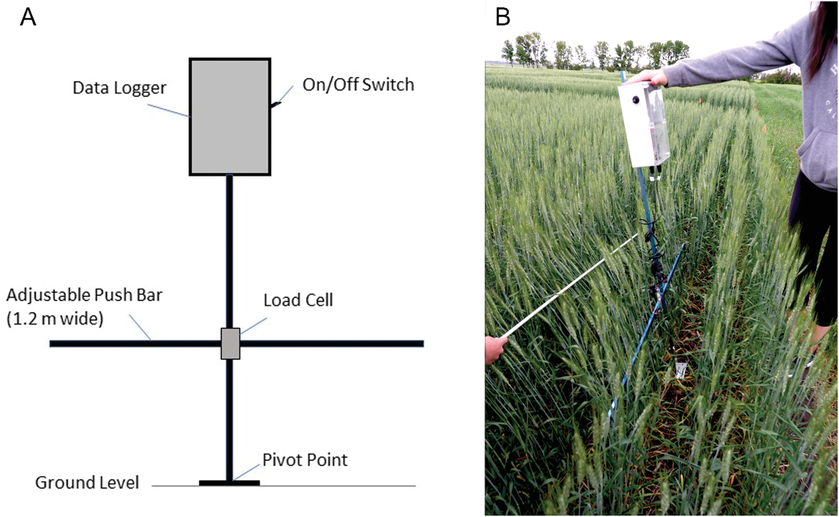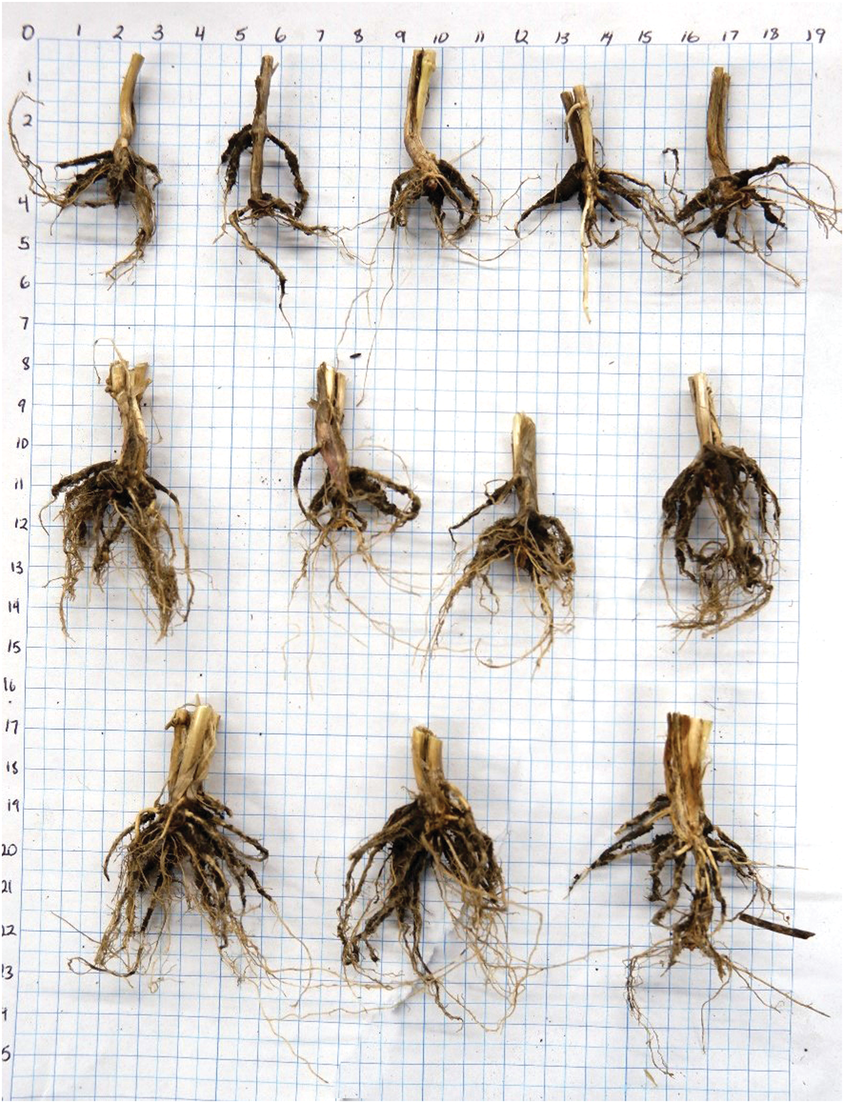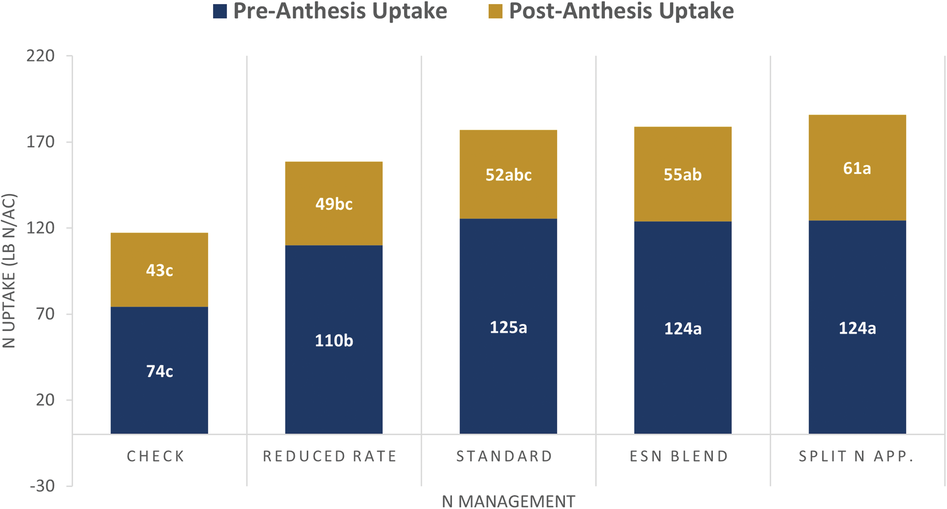Agronomic Practices to Minimize Lodging While Maximizing Yield and Protein of Spring Wheat in the Eastern Canadian Prairies

New high-yielding spring wheat cultivars are being grown widely across the Canadian Prairies. As yields rise, grain protein levels can only be maintained by increasing the N availability to crop, often reducing fertilizer use efficiency. An additional concern when increasing the amount of N fertilizer being applied to the crop is the increased risk of lodging, reducing the crop’s yield, quality, and harvestability. This article reports on research evaluating the effect of agronomic management practices on spring wheat lodging risk, grain yield, and protein content in the eastern Canadian Prairies. Earn 0.5 CEUs in Crop Management by reading this article and taking the quiz at https://web.sciencesocieties.org/Learning-Center/Courses.
New high‐yielding spring wheat cultivars are being grown widely across the Canadian Prairies. With these cultivars comes a new set of challenges to manage the agronomic, economic, and environmental risks associated with higher input requirements. As yields rise, grain protein levels can only be maintained by increasing the N availability to crop, often reducing fertilizer use efficiency (Barraclough et al., 2010; Hawkesford & Riche, 2020). An additional concern when increasing the amount of N fertilizer being applied to the crop is the increased risk of lodging, reducing the crop’s yield, quality, and harvestability (Berry, 2019).
There are two types of lodging that occur in wheat fields, stem and root. The plant characteristics and conditions that influence each lodging type are not necessarily the same, and agronomic management practices can influence these characteristics differently (Berry, 2000). Therefore, there is a need to determine the most effective agronomic management strategy, or combination of strategies, that create a crop that can better resistant lodging while maximizing resource partitioning to the developing grain. The objectives of this research were to evaluate the effect of agronomic management practices, including N management, plant density, plant growth regulator application and their interactions, on spring wheat lodging risk, grain yield, and protein content in the eastern Canadian Prairies.
To answer these objectives, two small‐plot field experiments were completed in southern Manitoba at two locations during the 2018 and 2019 growing seasons, for a total of four site‐years per experiment. Treatments included in Experiment 1 were three high‐yielding varieties, AAC Brandon (Canadian Western Hard Red, CWRS), AAC Cameron (CWRS), and Prosper (Canadian Northern Hard Red, CNHR). Five N treatments were included: a zero N check, a standard practice reflective of current N fertilization practices for high‐yielding spring wheat in the eastern Canadian Prairies, and three different N management strategies with contrasting rate, source, and timing (Table 1). At stem elongation (Zadoks Growth Stage 31), the addition, or absence, of the plant growth regulator (PGR) chlormequat chloride was applied to all combinations of cultivars and N treatments. Experiment 2 was conducted entirely on the cultivar AAC Brandon with experimental treatments focused on low (15 plants/ft2), medium (25 plants/ft2), or high (35 plants/ft2) plant densities, N application timing (entirely at planting vs. split application at planting and flag leaf), and the presence or absence of the PGR chlormequat chloride.
Main plot—cultivar | |||
|---|---|---|---|
| Wheat classa | Heightb | Lodging ratingbc |
AAC Brandon | CWRS | 81 | VG |
AAC Cameron | CWRS | 94 | G |
Prosper | CNHR | 84 | G |
Subplot—N management | |||
| Total N rate | App. timing | N source |
Check | 0 lb N/ac |
|
|
Reduced rate | 70 lb N/ac | Seeding | Urea |
Standard | 140 lb N/ac | Seeding | Urea |
ESN blend | 100 + 40 lb N/ac | Seeding | ESN + urea |
Split N app. | 70 + 70 lb N/ac | Seeding + flag leaf | Urea + Super U |
Sub-subplot—PGR | |||
| Product | App. timing | Rate |
- CCC |
|
|
|
+ CCC | Chlormequat chloride | Stem elongationc | 24.6 oz/ac |
- Canadian wheat classification: CWRS; Canadian Western Red Spring, CNHR; Canadian Northern Hard Red.
- Height and lodging rating from Manitoba Variety Evaluation Trials summarized at Seed Manitoba (https://www.seedmb.ca/). VG; Very good, G; Good.
- Zadoks Growth Stage 31, first node detectable and 1 cm above tillering node.
Lodging risk was determined in both experiments with visual lodging ratings, and a non‐destructive push‐force meter was used in field to indicate stem strength for each plot (Figure 1). Detailed plant morphological measurements such as structural root plate width and depth, stem diameter, and internode length were taken from select treatments to help better understand the driving factors influencing both stem and root lodging risk for all agronomic management practices tested.

The influence of N management and PGR application on yield, protein, N uptake, and N utilization patterns across commonly grown cultivars was examined in Experiment 1. Nitrogen uptake and accumulation in plant tissue was determined at anthesis for each plot as well as maturity. The N uptake efficiency (NUpE), grain N utilization efficiency (GNUtE), and overall grain N use efficiency (GNUE) were calculated:
NUpE = Aboveground N at Maturity/[Soil Residual Nitrate (0–120 cm) + Fertilizer N)]
GNUtE = Grain N/Total N Uptake at MaturityGNUE= NUpE × GNUtE
Lodging Risk
Reduced plant densities, split N applications, and the applications of a PGR showed the most potential to reduce lodging risk without sacrificing grain yield or protein levels. By reducing target plant densities to 15 plants/ft2 from 35 plants/ft2, we observed an increase in the crop’s ability to resist both stem and root lodging. Stem strength was increased and stem diameter increased while the structural root plate was increased (Figure 2), increasing the anchorage strength of the crop, allowing it to resist rotation. Plant density was the only management practice tested that showed the ability to alter crop anchorage strength. However, there are additional considerations that need to be taken into account when reducing plant densities. These include early‐season weed control and reduced crop competitiveness as well as increased variability in crop staging due to increased tillering per plant, which may make staging for crop protection applications more difficult and potentially reduce efficacy.

Stem strength was increased using spit N applications when compared with a similar rate of N applied entirely at planting. This was due to reduced early‐season vegetative growth, which decreased early‐season shading in the canopy and allowed for increased stem structural development. Split N applications have the added benefit of potentially increasing grain protein content but also require an additional pass across the crop during the growing season when labor and equipment may already be in high demand. With split application, there is also a risk that late‐applied N will not have enough time to be taken up into the crop in the absence of late‐season rainfall.
The application of the PGR chlormequat chloride reduced lodging through decreased plant height, lowering the amount of wind and rain the crop intercepted, as well as through increases in stem strength, measured by the push‐force meter. In this study, PGR application reduced lodging risk at high plant densities and when large amounts of N were applied at planting, making it a valuable in‐season tool for farmers to reduce lodging risk in spring wheat based on the current crop and early‐season environmental conditions.
Grain Yield and Protein
Grain yield was slightly lower for the variety AAC Cameron compared with AAC Brandon and Prosper while the grain protein was slightly lower from Prosper compared with the other two varieties (Table 2). For the three N management strategies tested, grain yield was similar to the standard practice of applying a high rate of N, as urea, entirely at seeding. However, applying N as a split application between seeding and flag leaf timing did increase protein content from 13.6 to 14.1% when the same total amount of N fertilizer was applied. As expected, reducing the rate of N there was a significant reduction in grain protein. The application of the PGR chlormequat chloride resulted in a small (2 bu/ac) but consistent yield increase compared with when no PGR was applied; this was a result of an increased number of kernels per spike and a slight decrease in protein content from 13.1 to 12.9% (Table 2). There was no significant difference between grain yield or protein content across all plant density treatments tested (from 15 to 35 plants/ft2).
2 Table Least square means for yield and yield components for the main effects of cultivar, nitrogen (N) management, and plant growth regulator (PGR) application of chlormequat chloride (CCC) for Experiment 1.
| Main effects | Grain yield | Grain protein content | Plant densitya | Spikes per plant | Kernels per spike | Kernel weight |
|---|---|---|---|---|---|---|
| bu/ac | % | plants/ft2 | g per 1,000 kernels | |||
| Cultivar | ||||||
| AAC Brandon | 73 ab | 13.3a | 23 a | 2.0 b | 33.2 a | 34.0 c |
| AAC Cameron | 67 b | 13.2a | 22 a | 1.9 b | 31.2 b | 35.6 b |
| Prosper | 73 a | 12.4b | 18 b | 2.6 a | 31.0 b | 36.4 a |
| N management | ||||||
| Check | 59 b | 11.1 d | 21 | 2.2 a | 30.9 c | 35.5 |
| Reduced Rate | 72 a | 12.4 c | 21 | 2.3 a | 31.4 bc | 35.6 |
| Standard | 75 a | 13.6 b | 21 | 2.3 a | 32.2 bc | 35.0 |
| ESN Blend | 75 a | 13.6 b | 21 | 2.3 a | 32.7 a | 35.1 |
| Split App. | 75 a | 14.1 a | 21 | 2.3 a | 31.9 abc | 35.4 |
| PGR | ||||||
| - CCC | 70 b | 13.1 a | 21 | 2.1 | 31.4 b | 36.5 a |
| + CCC | 72 a | 12.9 b | 21 | 2.2 | 32.2 a | 35.0 b |
Note. Within columns and main effects, means followed by the same letter are not significantly different at the .05 probability level. Due to a data collection error, plant density and spikes per plant data from one site year were excluded.
Nitrogen Uptake Timing and Use Efficiency
When the high rate of N fertilizer was applied (140 lb N/ac), the average N uptake efficiency was 80%, which was paired with a grain N utilization efficiency of 80%. As a result, the overall final grain N use efficiency was 60%, indicating that only 60% of the N that was available to the crop was present in the final grain N content. The efficiencies of N use were influenced very little by management practices in this study. However, management as well as variety did influence the timing of N uptake and how the crop utilized N to produce grain N. Overall, 55 to 80% of the crop’s N was taken up during the pre‐anthesis growth stage with 20 to 45% taken up post‐anthesis. AAC Brandon took up a larger portion of its total N during the late growing season (36%) compared with AAC Cameron (29%) and Prosper (30%), but the total growing season N uptake was similar across all varieties tested.
When the high rate of N was applied, the total amount of N taken up during the growing season was similar regardless of N source or application timing, but the split N application treatment did take up more N during the post‐anthesis growth stages than the standard practices and the ESN blend (Figure 3). The increase in late‐season uptake with split N applications was significant overall, but there was an interaction with growing season environment. This interaction emphasizes the reliance on late‐season precipitation for post‐anthesis N uptake. This interaction also corresponded with the increases in grain protein content when half of the N fertilizer was applied at the flag leaf stage, indicating that if conditions are favorable for late‐season uptake, split N applications will increase grain protein content through increased late‐season uptake. The application of chlormequat chloride did significantly reduce total N uptake by 4.4 lb N/ac compared with the untreated plots, potentially partially explaining the small reduction in grain protein content with PGR application.

Early‐season N supply is important for grain yield and protein in the eastern Canadian Prairies when growing season conditions are unpredictable. However, when large amounts of N are applied early in the season, lodging risk is increased, so there needs to be a balance with other lodging management tools such as reduced plant densities and PGR applications. Reduced plant densities have the greatest ability to reduce lodging risk by increasing both stem and anchorage strength of the plant; however, there may be hesitation around the adoption of this practice because it may reduce early‐season crop competitiveness with weeds. Additionally, the decision to use a reduced plant density needs to be made before the crop is established and yield potential and lodging risks of the growing season are unknown. The application of a PGR occurs in season, which would allow for evaluation on lodging risk and yield potential before the management decision needs to be made. Additionally, this study showed that the application of chlormequat chloride, even in the absence of lodging, had the ability to increase grain yield through increased number of kernels per spike, potentially covering the cost of the application.
DIG DEEPER
For more detailed information on this study, see these open access publications:
Mangin, A., Brûlé‐Babel, A., Flaten, D., Wiersma, J., & Lawley, Y. (2022). Maximizing spring wheat productivity in the eastern Canadian Prairies: I. Yield, yield components, and lodging risk. Agronomy Journal, 114, 1731–1751. https://doi.org/10.1002/agj2.21044
Mangin, A., Brûlé‐Babel, A., Flaten, D., Wiersma, J., & Lawley, Y. (2022). Maximizing spring wheat productivity in the eastern Canadian Prairies: II. Grain nitrogen, grain protein, and nitrogen use. Agronomy Journal, 114, 2389–2406. https://doi.org/10.1002/agj2.21080
Mangin, A., Brûlé‐Babel, A., Flaten, D., Wiersma, J., & Lawley, Y. (2022). Canopy management: the balance between lodging risk and nitrogen use for spring wheat production in the Canadian Prairies. Canadian Journal of Plant Science, 102. https://doi.org/10.1139/cjps‐2021‐0287
Mangin, A., Heuschele, J., Brule‐Babel, A., Flaten, D., Wiersma, J., & Lawley, Y. (2022). Rapid in situ nondestructive evaluation of lodging risk in dryland agronomic wheat research. Agronomy Journal, 114, 2822–2829. https://doi.org/10.1002/agj2.21173
References
Barraclough, P.B., Lopez‐Bellido, R., & Hawkesford, M.J. (2014). Genotypic variation in the uptake, partitioning and remobilisation of nitrogen during grain‐filling in wheat. Field Crops Research, 156, 242–248. https://doi.org/10.1016/j.fcr.2013.10.004
Berry, P.M., Griffin, J.M., Sylvester‐Bradley, R., Scott, R.K., Spink, J.H., Baker, C.J., & Clare, R.W. (2000). Controlling plant form through husbandry to minimise lodging in wheat. Field Crops Research, 67, 59–81. https://doi.org/10.1016/S0378‐4290(00)00084‐8
Berry, P.M. (2019). Lodging resistance in cereals. In R. Savin and G. Slafer (Eds.), Crop science. Encyclopedia of sustainability science and technology series. https://doi.org/10.1007/978‐1‐4939‐8621‐7_228
Hawkesford, M.J., & Riche, A.B. (2020). Impacts of G × E × M on nitrogen use efficiency in wheat and future prospects. Frontiers in Plant Science, 11, 1–9. https://doi.org/10.3389/fpls.2020.01157
Self-Study CEU Quiz
Earn 0.5 CEUs in Crop Management by taking the quiz for the article at https://web.sciencesocieties.org/Learning-Center/Courses. For your convenience, the quiz is printed below. The CEU can be purchased individually, or you can access as part of your Online Classroom Subscription.
- Which of the following practices do the authors say has the greatest ability to reduce spring wheat lodging risk in the eastern Canadian Prairies?
- Applying large amounts of N early in the season.
- Planting later in the season.
- Reducing plant densities.
- Increasing irrigation during grain filling.
- Which of the following increased in the crop when plant densities were reduced from 35 to 15 plants/ft2?
- Stem strength.
- Stem diameter.
- The structural root plate.
- All of the above.
- How did applying chlormequat chloride affect the crop?
- Decreased plant height.
- Increased the amount of wind and rain intercepted.
- Decreased stem strength.
- Increased lodging.
- Protein content was increased when
- chlormequat chloride was applied.
- N was applied as a split application between seeding and flag leaf.
- plant density was reduced.
- the variety Prosper was planted.
- The efficiencies of N use were influenced very little by management practices in this study.
- True.
- False.
Text © . The authors. CC BY-NC-ND 4.0. Except where otherwise noted, images are subject to copyright. Any reuse without express permission from the copyright owner is prohibited.










